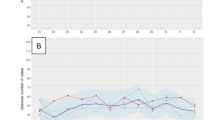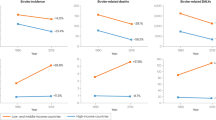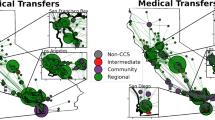Abstract
This Review focuses on the application of telemedicine to the care of patients with acute stroke (telestroke), from the prehospital setting through hospitalization. Telestroke has grown remarkably in the past decade and has entered mainstream care for patients with acute stroke. Telestroke enables such patients to be remotely evaluated, thereby allowing optimal treatment and management even in clinically underserved areas and removing geographical disparities in access to expert care. Telestroke systems enable thrombolytic treatment to be administered in community and rural hospitals, and facilitate the appropriate transfer of patients with complex conditions (who require critical care services and neurosurgical or intra-arterial interventions) to a comprehensive stroke centre. Decision-analytic models show that telestroke is cost-effective from both a societal and a hospital perspective. Limitations to the use of telestroke in the USA include the need for state licensing and credentialling of physicians, and the technical requirements of a minimum network bandwidth (which is still lacking in some regions). However, the opportunity exists for telestroke to become the backbone of an electronic stroke unit and to be used to identify and enrol patients in clinical trials of acute stroke treatment. The use of telestroke in the prehospital setting has been hampered by limited telecommunication availability, but these problems might be mitigated by fourth-generation cellular data networks.
Key Points
-
Telestroke networks have expanded in the past decade, enabling rural and community hospitals to administer tissue plasminogen activator to patients intravenously in a timely, safe and effective manner
-
Telestroke systems can also facilitate an electronic stroke unit, with ongoing follow-up and consultation by stroke specialists and nurse practitioners during the patient's hospitalization
-
Telestroke could improve the rate of recruitment and enrolment of under-represented populations of patients into clinical trials of acute stroke treatment
-
Telestroke is cost-effective from both societal and individual hospital perspectives
-
Barriers to telestroke implementation in the USA include the lack of nationwide credentialling and licensing programmes; the Center for Medicare Services has streamlined the credentialling process, but national licences are lacking
-
Telestroke is starting to move into the prehospital setting, but there are still technical barriers that might be mitigated by new fourth-generation cellular data networks
This is a preview of subscription content, access via your institution
Access options
Subscribe to this journal
Receive 12 print issues and online access
$209.00 per year
only $17.42 per issue
Buy this article
- Purchase on Springer Link
- Instant access to full article PDF
Prices may be subject to local taxes which are calculated during checkout




Similar content being viewed by others
References
Levine, S. R. & Gorman, M. “Telestroke”: the application of telemedicine for stroke. Stroke 30, 464–469 (1999).
Lees, K. R. et al. Time to treatment with intravenous alteplase and outcome in stroke: an updated pooled analysis of ECASS, ATLANTIS, NINDS, and EPITHET trials. Lancet 375, 1695–1703 (2010).
Kleindorfer, D. et al. US geographic distribution of rt-PA utilization by hospital for acute ischemic stroke. Stroke 40, 3580–3584 (2009).
Silva, G. S., Farrell, S., Shandra, E., Viswanathan, A. & Schwamm, L. H. The status of telestroke in the United States: a survey of currently active stroke telemedicine programs. Stroke 43, 2078–2085 (2012).
Pedragosa, A. et al. Impact of telemedicine on acute management of stroke patients undergoing endovascular procedures. Cerebrovasc. Dis. 34, 436–442 (2012).
Switzer, J. A. et al. A telestroke network enhances recruitment into acute stroke clinical trials. Stroke 41, 566–569 (2010).
Audebert, H. J. et al. Effects of the implementation of a telemedical stroke network: the Telemedic Pilot Project for Integrative Stroke Care (TEMPiS) in Bavaria, Germany. Lancet Neurol. 5, 742–748 (2006).
Switzer, J. A., Levine, S. R. & Hess, D. C. Telestroke 10 years later—'telestroke 2.0'. Cerebrovasc. Dis. 28, 323–330 (2009).
Audebert, H. J. et al. Is mobile teleconsulting equivalent to hospital-based telestroke services? Stroke 39, 3427–3430 (2008).
Wechsler, L. R. et al. Teleneurology applications: Report of the Telemedicine Work Group of the American Academy of Neurology. Neurology 80, 670–676 (2013).
Rubin, M. N., Wellik, K. E., Channer, D. D. & Demaerschalk, B. M. Systematic review of teleneurology: methodology. Front. Neurol. 3, 156 (2012).
Rubin, M. N., Wellik, K. E., Channer, D. D. & Demaerschalk, B. M. A systematic review of telestroke. Postgrad. Med. 125, 45–50 (2013).
Handschu, R. et al. Telemedicine in emergency evaluation of acute stroke: interrater agreement in remote video examination with a novel multimedia system. Stroke 34, 2842–2846 (2003).
Meyer, B. C., Raman, R., Chacon, M. R., Jensen, M. & Werner, J. D. Reliability of site-independent telemedicine when assessed by telemedicine-naive stroke practitioners. J. Stroke Cerebrovasc. Dis. 17, 181–186 (2008).
Wang, S. et al. Remote evaluation of acute ischemic stroke: reliability of National Institutes of Health Stroke Scale via telestroke. Stroke 34, e188–e191 (2003).
Shafqat, S., Kvedar, J. C., Guanci, M. M., Chang, Y. & Schwamm, L. H. Role for telemedicine in acute stroke. Feasibility and reliability of remote administration of the NIH stroke scale. Stroke 30, 2141–2145 (1999).
Schwamm, L. H. et al. A review of the evidence for the use of telemedicine within stroke systems of care: a scientific statement from the American Heart Association/American Stroke Association. Stroke 40, 2616–2634 (2009).
Demaerschalk, B. M. et al. Vascular neurology nurse practitioner provision of telemedicine consultations. Int. J. Telemed. Appl. 2010, 507071 (2010).
Meyer, B. C. et al. Prospective reliability of the STRokE DOC wireless/site independent telemedicine system. Neurology 64, 1058–1060 (2005).
Gonzalez, M. A., Hanna, N., Rodrigo, M. E., Satler, L. F. & Waksman, R. Reliability of prehospital real-time cellular video phone in assessing the simplified National Institutes Of Health Stroke Scale in patients with acute stroke: a novel telemedicine technology. Stroke 42, 1522–1527 (2011).
Anderson, E. R., Smith, B., Ido, M. & Frankel, M. Remote assessment of stroke using the iPhone 4. J. Stroke Cerebrovasc. Dis. http://dx.doi.org/10.1016/j.jstrokecerebrovasdis.2011.09.013.
Demaerschalk, B. M. et al. Reliability of real-time video smartphone for assessing National Institutes of Health stroke scale scores in acute stroke patients. Stroke 43, 3271–3277 (2012).
Schwamm, L. H. et al. Virtual TeleStroke support for the emergency department evaluation of acute stroke. Acad. Emerg. Med. 11, 1193–1197 (2004).
Wiborg, A. & Widder, B. Teleneurology to improve stroke care in rural areas: The Telemedicine in Stroke in Swabia (TESS) Project. Stroke 34, 2951–2956 (2003).
Hess, D. C. et al. REACH: clinical feasibility of a rural telestroke network. Stroke 36, 2018–2020 (2005).
Wang, S. et al. Remote evaluation of acute ischemic stroke in rural community hospitals in Georgia. Stroke 35, 1763–1768 (2004).
Audebert, H. J. et al. Telemedicine for safe and extended use of thrombolysis in stroke: the Telemedic Pilot Project for Integrative Stroke Care (TEMPiS) in Bavaria. Stroke 36, 287–291 (2005).
Sairanen, T. et al. Two years of Finnish Telestroke: thrombolysis at spokes equal to that at the hub. Neurology 76, 1145–1152 (2011).
Switzer, J. A. et al. A web-based telestroke system facilitates rapid treatment of acute ischemic stroke patients in rural emergency departments. J. Emerg. Med. 36, 12–18 (2009).
Meyer, B. C. et al. Efficacy of site-independent telemedicine in the STRokE DOC trial: a randomised, blinded, prospective study. Lancet Neurol. 7, 787–795 (2008).
Demaerschalk, B. M., Raman, R., Ernstrom, K. & Meyer, B. C. Efficacy of telemedicine for stroke: pooled analysis of the Stroke Team Remote Evaluation Using a Digital Observation Camera (STRokE DOC) and STRokE DOC Arizona telestroke trials. Telemed. J. E Health 18, 230–237 (2012).
Johnston, K. C. & Worrall, B. B. Teleradiology Assessment of Computerized Tomographs Online Reliability Study (TRACTORS) for acute stroke evaluation. Telemed. J. E Health 9, 227–233 (2003).
Puetz, V. et al. Reliability of brain CT evaluation by stroke neurologists in telemedicine. Neurology 80, 332–338 (2013).
Demaerschalk, B. M. et al. CT interpretation in a telestroke network: agreement among a spoke radiologist, hub vascular neurologist, and hub neuroradiologist. Stroke 43, 3095–3097 (2012).
Jauch, E. C. et al. Guidelines for the early management of patients with acute ischemic stroke: a guideline for healthcare professionals from the American Heart Association/American Stroke Association. Stroke 44, 870–947 (2013).
Audebert, H. J. et al. Long-term effects of specialized stroke care with telemedicine support in community hospitals on behalf of the Telemedical Project for Integrative Stroke Care (TEMPiS). Stroke 40, 902–908 (2009).
McConnell, K. J. et al. The on-call crisis: a statewide assessment of the costs of providing on-call specialist coverage. Ann. Emerg. Med. 49, 727–733 (2007).
Rudkin, S. E. et al. The worsening of ED on-call coverage in California: 6-year trend. Am. J. Emerg. Med. 27, 785–791 (2009).
Josephson, S. A., Engstrom, J. W. & Wachter, R. M. Neurohospitalists: an emerging model for inpatient neurological care. Ann. Neurol. 63, 135–140 (2008).
Vatankhah, B., Schenkel, J., Furst, A., Haberl, R. L. & Audebert, H. J. Telemedically provided stroke expertise beyond normal working hours. The Telemedical Project for Integrative Stroke Care. Cerebrovasc. Dis. 25, 332–337 (2008).
[No authors listed] The Joint Commission reports high interest in new certification program for Comprehensive Stroke Centers. ED Manag. 24, 127–129 (2012).
Alberts, M. J. et al. Recommendations for comprehensive stroke centers: a consensus statement from the Brain Attack Coalition. Stroke 36, 1597–1616 (2005).
Riedel, C. H. et al. The importance of size: successful recanalization by intravenous thrombolysis in acute anterior stroke depends on thrombus length. Stroke 42, 1775–1777 (2011).
Audebert, H. J. et al. Can. telemedicine contribute to fulfill WHO Helsingborg Declaration of specialized stroke care? Cerebrovasc. Dis. 20, 362–369 (2005).
Schwamm, L. H. et al. Recommendations for the implementation of telemedicine within stroke systems of care: a policy statement from the American Heart Association. Stroke 40, 2635–2660 (2009).
Chowdhury, M., Birns, J., Rudd, A. & Bhalla, A. Telemedicine versus face-to-face evaluation in the delivery of thrombolysis for acute ischaemic stroke: a single centre experience. Postgrad. Med. J. 88, 134–137 (2012).
Hargroves, D. Will telemedicine facilitate access to hyper acute stroke care across the UK? Br. J. Hosp. Med. (Lond.) 73, 155–159 (2012).
Stroke Unit Trialist's Collaboration. Organised inpatient (stroke unit) care for stroke. Cochrane Database of Systematic Reviews, Issue 4. Art. No.: CD000197. http://dx.doi.org/10.1002/14651858.CDCD000197.pub2.
Hess, D. C. & Switzer, J. A. Stroke telepresence: removing all geographic barriers. Neurology 76, 1121–1123 (2011).
Meretoja, A. et al. Reducing in-hospital delay to 20 minutes in stroke thrombolysis. Neurology 79, 306–313 (2012).
Walter, S. et al. Point-of-care laboratory halves door-to-therapy-decision time in acute stroke. Ann. Neurol. 69, 581–586 (2011).
Kohrmann, M. et al. Avoiding in hospital delays and eliminating the three-hour effect in thrombolysis for stroke. Int. J. Stroke 6, 493–497 (2011).
Bray, J. E. et al. Paramedic identification of stroke: community validation of the melbourne ambulance stroke screen. Cerebrovasc. Dis. 20, 28–33 (2005).
Kidwell, C. S., Starkman, S., Eckstein, M., Weems, K. & Saver, J. L. Identifying stroke in the field. Prospective validation of the Los Angeles prehospital stroke screen (LAPSS). Stroke 31, 71–76 (2000).
Kothari, R. U., Pancioli, A., Liu, T., Brott, T. & Broderick, J. Cincinnati Prehospital Stroke Scale: reproducibility and validity. Ann. Emerg. Med. 33, 373–378 (1999).
Harbison, J. et al. Diagnostic accuracy of stroke referrals from primary care, emergency room physicians, and ambulance staff using the face arm speech test. Stroke 34, 71–76 (2003).
Nazliel, B. et al. A brief prehospital stroke severity scale identifies ischemic stroke patients harboring persisting large arterial occlusions. Stroke 39, 2264–2267 (2008).
Whelley-Wilson, C. M. & Newman, G. C. A stroke scale for emergency triage. J. Stroke Cerebrovasc. Dis. 13, 247–253 (2004).
Llanes, J. N. et al. The Los Angeles Motor Scale (LAMS): a new measure to characterize stroke severity in the field. Prehosp. Emerg. Care 8, 46–50 (2004).
Tirschwell, D. L. et al. Shortening the NIH Stroke scale for use in the prehospital setting. Stroke 33, 2801–2806 (2002).
McKinney, J. S. et al. Hospital prenotification of stroke patients by emergency medical services improves stroke time targets. J. Stroke Cerebrovasc. Dis. 22, 113–118 (2013).
Ziegler, V. et al. Mobile computing systems in preclinical care of stroke. Results of the Stroke Angel initiative within the BMBF project PerCoMed. Anaesthesist 57, 677–685 (2008).
Berglund, A. et al. Higher prehospital priority level of stroke improves thrombolysis frequency and time to stroke unit: the Hyper Acute STroke Alarm (HASTA) study. Stroke 43, 2666–2670 (2012).
Lin, C. B. et al. Emergency medical service hospital prenotification is associated with improved evaluation and treatment of acute ischemic stroke. Circ. Cardiovasc. Qual. Outcomes 5, 514–522 (2012).
LaMonte, M. P. et al. Shortening time to stroke treatment using ambulance telemedicine: TeleBAT. J. Stroke Cerebrovasc. Dis. 13, 148–154 (2004).
Liman, T. G. et al. Telestroke ambulances in prehospital stroke management: concept and pilot feasibility study. Stroke 43, 2086–2090 (2012).
Bergrath, S. et al. Feasibility of prehospital teleconsultation in acute stroke–a pilot study in clinical routine. PLoS ONE 7, e36796 (2012).
Walter, S. et al. Diagnosis and treatment of patients with stroke in a mobile stroke unit versus in hospital: a randomised controlled trial. Lancet Neurol. 11, 397–404 (2012).
Weber, J. E. et al. Prehospital thrombolysis in acute stroke: results of the PHANTOM-S pilot study. Neurology 80, 163–168 (2013).
Ramanujam, P. et al. Accuracy of stroke recognition by emergency medical dispatchers and paramedics--San Diego experience. Prehosp. Emerg. Care 12, 307–313 (2008).
Govindarajan, P. et al. Comparative evaluation of stroke triage algorithms for emergency medical dispatchers (MeDS): prospective cohort study protocol. BMC Neurol. 11, 14 (2011).
Krebes, S. et al. Development and validation of a dispatcher identification algorithm for stroke emergencies. Stroke 43, 776–781 (2012).
Gierhake, D. et al. Mobile CT: technical aspects of prehospital stroke imaging before intravenous thrombolysis [German]. Rofo 185, 55–59 (2013).
Schwamm, L. H. & Starkman, S. Have CT—will travel: to boldly go where no scan has gone before. Neurology 80, 130–131 (2013).
Lai, F. Stroke networks based on robotic telepresence. J. Telemed. Telecare 15, 135–136 (2009).
Ehlers, L., Muskens, W. M., Jensen, L. G., Kjolby, M. & Andersen, G. National use of thrombolysis with alteplase for acute ischaemic stroke via telemedicine in Denmark: a model of budgetary impact and cost effectiveness. CNS Drugs 22, 73–81 (2008).
Nelson, R. E., Saltzman, G. M., Skalabrin, E. J., Demaerschalk, B. M. & Majersik, J. J. The cost-effectiveness of telestroke in the treatment of acute ischemic stroke. Neurology 77, 1590–1598 (2011).
Switzer, J. A. et al. Cost-effectiveness of hub-and-spoke telestroke networks for the management of acute ischemic stroke from the hospitals' perspectives. Circ. Cardiovasc. Qual. Outcomes 6, 18–26 (2013).
Schenkel, J. et al. Cost analysis of telemedical treatment of stroke [German]. Gesundheitswesen http://dx.doi.org/10.1055/s-0032-1321779.
Elkins, J. S., Khatabi, T., Fung, L., Rootenberg, J. & Johnston, S. C. Recruiting subjects for acute stroke trials: a meta-analysis. Stroke 37, 123–128 (2006).
Zerhouni, E. Medicine. The NIH roadmap. Science 302, 63–72 (2003).
Sanossian, N. et al. Simultaneous ring voice-over-Internet phone system enables rapid physician elicitation of explicit informed consent in prehospital stroke treatment trials. Cerebrovasc. Dis. 28, 539–544 (2009).
Owolabi, M. O. Taming the burgeoning stroke epidemic in Africa: stroke quadrangle to the rescue. West Indian Med. J. 60, 412–421 (2011).
Schwarz, H., Marpe, D, & Wiegand, T. Overview of the scalable video coding extension of the H.264/AVC standard. IEEE Trans. Circuits Systems Video Technol. 17, 1103–1120 (2007).
Switzer, J. A. & Demaerschalk, B. M. Overcoming challenges to sustain a telestroke network. J. Stroke Cerebrovasc. Dis. 21, 535–540 (2012).
Center for Medicaid, CHIP, and Survey & Certification/Survey & Certification Group. Telemedicine services in hospitals and critical access hospitals (CAHs). Centers for Medicare & Medicaid services [online], (2013).
Liang, B. A. & Zivin, J. A. Empirical characteristics of litigation involving tissue plasminogen activator and ischemic stroke. Ann. Emerg. Med. 52, 160–164 (2008).
Liang, B. A., Lew, R. & Zivin, J. A. Review of tissue plasminogen activator, ischemic stroke, and potential legal issues. Arch. Neurol. 65, 1429–1433 (2008).
Acknowledgements
H. J. Audebert acknowledges funding for the Telemedicine Project for Integrative Stroke Care (TEMPiS) network from Bavarian Health Insurance, Bavarian Ministry for Social Affairs, the German Foundation for Stroke Aid and the German Federal Ministry of Education and Research (BMBF), as well as funding for the Stroke Emergency Unit Mobile (STEMO) project from Zukunftsfonds Berlin and the Federal Ministry of Education and Research, via grant number 01 EO 0801 from the Center for Stroke Research, Berlin, Germany.
Author information
Authors and Affiliations
Contributions
D. C. Hess and H. J. Audebert contributed equally to discussion of content for the article, researching data to include in the manuscript, and writing, reviewing and editing of the manuscript before submission.
Corresponding author
Ethics declarations
Competing interests
D. C. Hess is a co-founder of and equity holder in REACH Health, a telestroke and telemedicine company. He is a member of the Board of Directors of REACH Health, but does not receive compensation for this role and does not receive compensation from the company. H. J. Audebert has received honoraria for acting as a speaker and/or consultant from Bayer Vital, Boehringer Ingelheim, Bristol–Myers Squibb, Lundbeck, Pfizer, Sanofi–Synthélabo, Takeda Pharmaceuticals, and UCB.
Rights and permissions
About this article
Cite this article
Hess, D., Audebert, H. The history and future of telestroke. Nat Rev Neurol 9, 340–350 (2013). https://doi.org/10.1038/nrneurol.2013.86
Published:
Issue Date:
DOI: https://doi.org/10.1038/nrneurol.2013.86
This article is cited by
-
Stroke care networks and the impact on quality of care
Health Care Management Science (2022)
-
Building cohesion in distributed telemedicine teams: findings from the Department of Veterans Affairs National Telestroke Program
BMC Health Services Research (2021)
-
The administration of rtPA before mechanical thrombectomy in acute ischemic stroke patients is associated with a significant reduction of the retrieved clot area but it does not influence revascularization outcome
Journal of Thrombosis and Thrombolysis (2021)
-
Teleneurology and mobile technologies: the future of neurological care
Nature Reviews Neurology (2018)
-
Telestroke
Current Cardiology Reports (2017)



